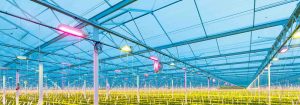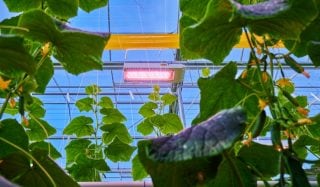Be the first! Get the latest news and updates - Subscribe to our newsletter!
8 choices to a cost-effective LED grow light
Smart design delivers longlasting performance - Part 2
To grow crops successfully and cost-effectively with LED grow lights, your LED system must be designed to perform reliably in the harsh conditions of your greenhouse environment. In part 2 of a 2-part series, we explain smart design choices 5-8 that we’ve made for Philips GreenPower LED toplighting compact that give you peace of mind. With this proven design, your Philips LED lighting system is guaranteed to work reliably for many years and much more than 36,000 hours of intensive use, while being easy to maintain and clean.
Before starting, it’s important to understand the terms we are using. When we say LEDs we are referring to the individual lamps. When we say LED grow light, it is the fixture that contains the LEDs, lens and other components to produce the right light for crops.
Smart design #5: Tempered glass with optical quality
The most important thing for growers is providing the most optimal and uniform light for their crop. To achieve that, you have to make smart choices in the material you use for the glass in front of the LEDs and the lens in the LED grow light. A key design choice that determines the clarity and color accuracy of the LED lamp is the type of glass we mount on it. We use tempered glass, which is much stronger than normal glass. This glass is also optical quality, meaning there is no lead in the glass, so it has no green tint, which could possibly change the color spectrum applied to the crop. The optical quality of our glass has just 3% loss in light transmission. The result is higher clarity, meaning less light loss, and higher color accuracy of the LED lighting output.
Smart design #6: The correct lens for uniform light distribution and light output over time
The lens is made from a special optical polycarbonate plastic which provides special optical qualities. In the past we used lenses based on a gel. However, over time this gel causes the lenses to turn yellow and eventually reduces the light output. With Philips GreenPower LED toplighting compact, we use a polycarbonate lens that holds up longer to extreme temperatures and is resistant to yellowing. The lens is mounted on 18 springs to ensure that it remains stationery even when the product heats up. We do this to guarantee the performance of the product at high temperatures.
How do we know this works? We have tested the additives that we put in the polycarbonate material for thousands of hours under high dose ultraviolet light. These tests confirm that the lens does not turn yellow. We leveraged knowledge from Signify research when choosing this material.

Optimized thermal resistance for very high light output, consistently over time
Smart design 7: Longlasting light performance
There are different types of LED lighting lenses available that provide the optimal light distribution for the height of your greenhouse and crop. Because there are many different shapes and sizes of greenhouses and crops, we calculate a certain buffer in our lighting plans to guarantee that our modules will provide sufficient light output and uniformity. That means our published specifications are always on the conservative side. So you can be sure that what you read on the box will definitely be what you experience in practice.
In general, the actual light performance that growers achieve with Philips GreenPower LED toplighting compact is better than the published specifications. We have been testing its light output in reference products in the field since we first introduced it and the results confirm that the product emits the correct light output as specified and even more based on numerous long-term measurements in customer installations.
| Customer | Crop | # of hours | PFD |
|---|---|---|---|
| Porta Nova | Roses | 15.000 | 98.7% |
| Wimceco | Roses | 13.500 | 101.5% |
| Valstar | Pot roses | 10.000 | 100% |
| Darolin | Chrysanthemum | 5.500 | 99.1% |
| De Vreede | Phaleanopsis | 20.000 | 98.8% |
| Wim Peters Kwekerijen | Tomatoes | 7.000 | 99.5% |
Results from field measurements at 6 different customers show that our LED modules perform according to their promised lifetime claims.
Smart design #8: What specifications are important when choosing an LED grow light?
Both ‘initial’ and ‘over time’ performance data have to be evaluated in order to have confidence in how LED grow lights will perform throughout their lifetime. Initial performance can be measured, but it is important to be aware that over time performance is a prediction based on extrapolated data. The lifetime of an LED grow light is always related to photon flux depreciation, but the technical design choices also make a tremendous difference in how it performs over its lifetime. For more information on this topic, read our blog on How to evaluate the credibility of LED grow light performance claims.
Some manufacturers give specifications for an individual LED lamp instead of a complete LED grow light. We always provide specifications for the complete LED module, called Wall Plug Efficacy (WPE), because how it is designed and manages heat, determines your actual light output and lifetime. An individual LED lamp, for example, might give off 4 µmol/J on its own, but when it is placed in a lighting module the light output of the entire module could be 3.6µmol/J. To optimize heat management in the design of our lighting modules, we place thermally conductive paste between the LED and the aluminum heat sink. This guarantees that the module will provide consistent performance over its lifetime.
To be sure you are reading a specification for the entire LED module, you should look for information about the method used to measure the LED fixture. To ensure standardized specifications, we always measure our LED modules in an official certified laboratory according to the LM-79-80 standards for luminaires. When comparing LED grow light products, you should always ask for the official report provided by the official certified measurement laboratories to ensure that you are comparing the specifications correctly.
Quality above everything
When developing a new product, we’re always looking at design aspects that can help make a grower’s business smarter, more efficient and more productive. This commitment to quality has made Philips LED lighting products the preferred choice for growers in over 43 countries because of the unrivalled quality and performance they deliver. With Philips GreenPower LED toplighting compact, you can rely on a proven product resulting from 15 years of experience and learnings in LED for horticulture applications. It helps you improve the quality and yield of your crops for a very long period of time to increase your return on investment.
Why partner with Signify?
You want to be sure to get a rapid return on your investment and have all aspects of your project carried out professionally. With Signify, your project is in experienced hands. Signify is the global leader in the lighting sector and has built up a substantial track record in more than 400 projects in the horticultural lighting market since 1995. This includes over two decades of dedicated experience developing tailor-made, LED-based light recipes that help growers speed up growth, increase yield and improve the quality of plants. With cutting-edge LED innovations at our command, we can custom-build a science-based solution for you.

René van Wees
Global Manager Application Engineering
René van Wees started his career at Philips Research Laboratory in 1987 and joined Philips lighting in 2003 to help develop a first commercial LED product for signage. In 2006 he started working in the new area of LED for horticulture, has been there ever since. He enjoys working as the linking pin between customers and product development, giving trainings, gathering customer feedback and advising them on LED for their applications. He works with a 10-member team to provide the best possible technical support to customers worldwide.
Related articles
Contact us
Contact certified partners
Philips products are sold through a global network of certified partners. Find partners in your region for more information about Philips LED grow lights.
Contact Philips
What are the best LED grow lights for your situation? We are here to help. Please use our form to submit your request.
Interested?
Learn more about LED lighting in horticulture by reading our latest articles and case studies.




